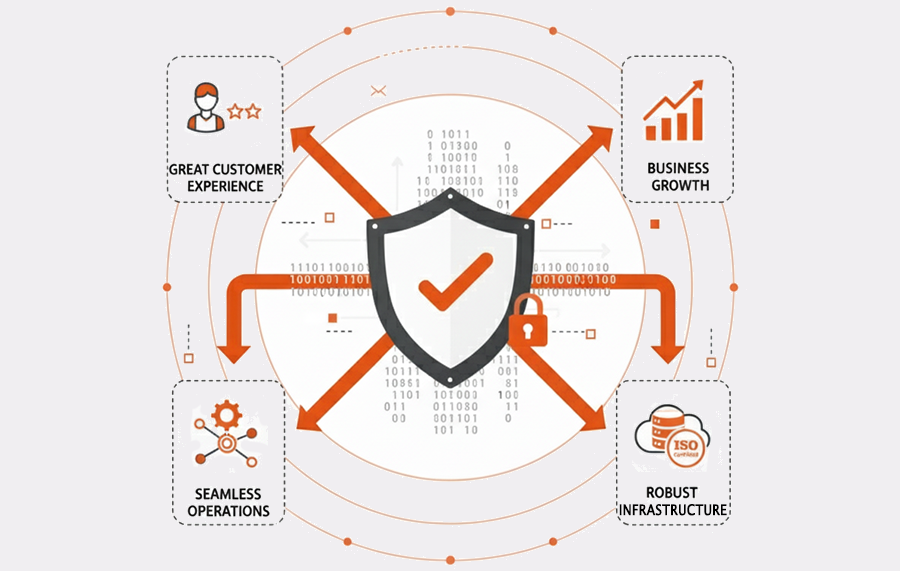29 January 2025
The Power of First Impressions: Why Your Digital Identity Matters

The Power of First Impressions: Why Your Digital Identity Matters
In the fast-paced digital age, your online presence is your brand’s handshake to the world. It’s where potential clients, partners, and customers first encounter your business. In fact, for most people, your website, social media, or online listings will be their first impression of your brand. And as the saying goes, “you never get a second chance to make a first impression.” That’s why Vpress is proud to unveil our new website, designed to reflect our core values, expertise, and commitment to innovation. This milestone has reminded us of how crucial a strong digital identity is for any business. Additionally, our branded Web-to-Print storefronts are a fantastic way to ensure your brand makes a great first impression, providing a seamless and professional experience for your clients.
Here, we delve into the importance of your digital identity and the key factors to consider when crafting a brand image that not only stands out but also drives trust and engagement.
Why Digital Identity is Critical for Your Brand
In an increasingly digital world, your online presence is no longer a luxury—it’s a necessity. Here’s why:
- First Impressions Are Online: Studies show that 81% of consumers research a business online before making a purchase decision. Your website, social media, and digital touchpoints act as the face of your brand.
- Trust and Credibility: A professional, consistent, and visually appealing digital presence builds trust. A poorly designed website or outdated content can create doubt, while a polished digital identity reassures visitors of your legitimacy.
- Competitive Edge: In saturated markets, your online identity is often the deciding factor between you and a competitor. A well-defined digital brand helps you stand out.
- 24/7 Accessibility: Unlike physical storefronts, your digital presence is always on. It’s a window into your brand that operates around the clock, catering to global audiences.
- Influencing Perception: Your online content, imagery, and messaging shape how people perceive your brand. An intentional approach ensures you’re conveying the right message to your target audience.
Key Factors to Improve Your Brand Image Online
If you’re looking to enhance your digital presence, here are the core elements you should focus on:
1. A Cohesive and Modern Website
Your website is often the cornerstone of your digital identity. Here’s what to prioritise:
- User Experience (UX): Ensure easy navigation, fast loading times, and mobile responsiveness.
- Visual Design: Use a clean, consistent design that reflects your brand’s personality.
- Clear Messaging: Communicate your value proposition and key offerings effectively.
- SEO Optimisation: Make sure your website is discoverable by optimising for search engines.
2. Consistent Branding Across Platforms
Your logo, colour palette, typography, and tone of voice should remain consistent across all digital platforms—from your website to your social media pages. This consistency fosters recognition and trust.
3. Engaging Content
Content is the bridge between your brand and your audience. High-quality, relevant content helps build authority and engagement. Focus on:
- Blog posts that address your audience’s pain points.
- Thought leadership articles showcasing your expertise.
- Visual content such as videos, infographics, and branded photography.
4. Social Media Presence
Your social media channels are powerful tools for building relationships with your audience. Tips to optimise your presence:
- Post regularly and stay active in engaging with followers.
- Tailor your content to each platform.
- Leverage analytics to understand what resonates with your audience.
5. Online Reviews and Testimonials
Positive reviews and testimonials act as social proof. Encourage satisfied clients to leave reviews on platforms like Google, LinkedIn, or industry-specific directories.
6. Secure and Professional Communication
An official email domain, secure website (with HTTPS), and professional customer service set a high standard for trust and reliability.
7. Monitor and Adapt
The digital landscape evolves rapidly. Regularly review your website analytics, social media performance, and customer feedback to adapt your digital strategy.
Conclusion
Your digital identity is the gateway to your brand, often serving as the first interaction someone has with your business. By prioritising a cohesive and engaging online presence, you not only make a strong first impression but also build trust, drive loyalty, and set your brand apart in the competitive digital landscape.
Frequently Asked Questions
How do branded web to print storefronts enhance your digital identity?
Branded web to print storefronts significantly enhance your digital identity by providing a professional, cohesive online presence that operates 24/7. These customizable portals reflect your brand's visual identity through logos, colors, and messaging while offering seamless print ordering experiences. By integrating your brand elements throughout the ordering process - from login screens to order confirmations - web to print storefronts ensure every customer touchpoint reinforces your brand identity, builds trust, and delivers the polished first impression that modern buyers expect.
What role does web to print technology play in building customer trust online?
Web to print technology builds customer trust by providing transparency, consistency, and professionalism throughout the print ordering process. Features like real-time pricing, instant visual proofs, secure payment processing, and order tracking demonstrate reliability and technological sophistication. When customers can see exactly what they're ordering, understand costs upfront, and track their orders in real-time, it creates confidence in your business. This transparency, combined with a professional branded interface, positions your print business as trustworthy and customer-focused in the digital marketplace.
How can print service providers use web to print portals to stand out from competitors?
Print service providers can differentiate themselves through web to print portals by offering unique customer experiences that go beyond basic online ordering. This includes implementing personalized user dashboards, offering advanced design tools with real-time previews, providing instant quotes with transparent pricing, creating custom workflows for different customer segments, and integrating value-added services like inventory management and automated reordering. By focusing on user experience and leveraging the full capabilities of web to print technology, PSPs can create a distinctive digital presence that sets them apart in a crowded market.
Why is 24/7 accessibility through web to print crucial for modern brand identity?
24/7 accessibility through web to print is crucial for modern brand identity because it aligns with customer expectations for always-on service in the digital age. Unlike traditional print ordering methods, web to print portals never close, allowing customers to browse, design, and order whenever convenient - whether that's during lunch breaks, after hours, or across different time zones. This constant availability not only captures more business opportunities but also positions your brand as modern, customer-centric, and responsive to the needs of today's busy professionals who expect instant access to services.
How does implementing web to print software improve brand consistency across digital channels?
Web to print software improves brand consistency by centralizing brand assets and enforcing design guidelines across all customer touchpoints. Through template-based systems, businesses can ensure logos, colors, fonts, and messaging remain consistent whether customers are ordering business cards, marketing materials, or signage. The software can lock certain brand elements while allowing customization in designated areas, preventing brand dilution. Additionally, integration with other digital channels like websites and marketing platforms creates a unified brand experience, reinforcing your professional image and making your business more memorable and trustworthy to customers.


